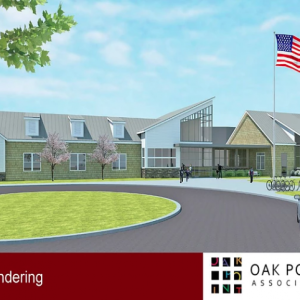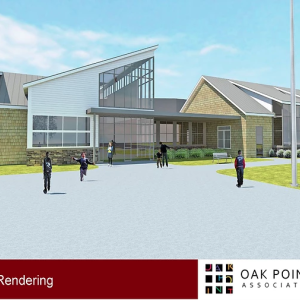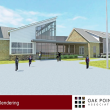Supporters of new Camden middle school rally for June 13 polls; residents question need for MET demolition
 Architectural renderings of the proposed new Camden-Rockport Middle School. (Courtesy https://crmsmiddlematters.wixsite.com/crms-middle-matters/proposed-project)
Architectural renderings of the proposed new Camden-Rockport Middle School. (Courtesy https://crmsmiddlematters.wixsite.com/crms-middle-matters/proposed-project)
 Architectural renderings of the proposed new Camden-Rockport Middle School. (Courtesy https://crmsmiddlematters.wixsite.com/crms-middle-matters/proposed-project)
Architectural renderings of the proposed new Camden-Rockport Middle School. (Courtesy https://crmsmiddlematters.wixsite.com/crms-middle-matters/proposed-project)

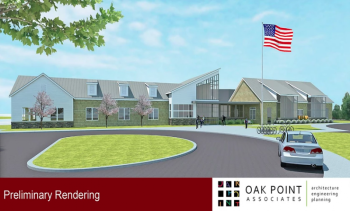 Architectural renderings of the proposed new Camden-Rockport Middle School. (Courtesy https://crmsmiddlematters.wixsite.com/crms-middle-matters/proposed-project)
Architectural renderings of the proposed new Camden-Rockport Middle School. (Courtesy https://crmsmiddlematters.wixsite.com/crms-middle-matters/proposed-project)
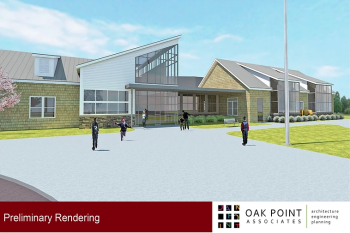 Architectural renderings of the proposed new Camden-Rockport Middle School. (Courtesy https://crmsmiddlematters.wixsite.com/crms-middle-matters/proposed-project)
Architectural renderings of the proposed new Camden-Rockport Middle School. (Courtesy https://crmsmiddlematters.wixsite.com/crms-middle-matters/proposed-project)

CAMDEN/ROCKPORT — The red signs, Middle Matters, are ubiquitous throughout Camden and Rockport — at well-traveled intersections and on private front yards — indicating support for spending $26 million on tearing down the Camden-Rockport Middle School buiildings on Knowlton Street, in Camden, and replacing them with a brand new facility. There has been little opposition to demolishing the old high school, and Andrews Wing of the school, but some have questioned removing the Mary E. Taylor portion of the school, a brick building constructed in 1925.
The public outreach for the middle school project is complete: Volunteers created a comprehensive website, mailings were sent to all voters explaining the reasoning and project financing, Superintendent Maria Libby spoke to Camden and Rockport select boards, and on June 5, there was one final tour of CRMS for citizens to review structural problems there.
Parents, teachers, school board members and administrators have advocated that the money be spent on a new school for grades five through eight, as opposed to maintaining what is there now.
And parts of that existing 122,000-square-foot complex borders on being derelict; its heating system is outdated, pipes leak, and tiles are coming loose. To fix the existing buildings would cost at least $17 million, and what is the sense, supporters have asked, of ‘throwing good money after bad.’
Who was Mary E. Taylor? According to the Camden Town Report, 1928, Mary E. Taylor was Principal of the Camden Grade School and she taught mathematics. Back then, the school was referred to as the “brick building.”
Plus, they say, the space is not geared well toward academic programs.
But while there has been strong vocal support through the community for a new middle school, there is likewise a growing concern about tearing down the Mary E. Taylor (MET) building.
Camden resident Robin McIntosh supports building a new middle school and plans to vote yes on the ballot. She also appreciates the opportunity to, “once again look at the possibility of saving the MET as the school board moves forward with their planning. I realize that there was some discussion about saving the MET around the time of the last middle school vote, but I don’t believe that there was a serious conversation at the town level about what options might exist if it were to be accepted. We need to have that discussion.”
She wants “a good faith conversation about saving it.”
Alhough the demolition of MET is part of the project proposal, at least one school board member, Matt Dailey, said recently that could change, if the public or private investor made a competing proposal.
In fact, the SAD 28 School Board plans to revisit the MET question at its June 15 school board meeting, the day after town meeting and two days after election day.
Camden-Rockport Middle School history
The original structure, the Mary E. Taylor Elementary School, was built in 1925 for grades one through eight. It is a 28,200 square-foot three-story (plus a fourth-story penthouse) academic facility.
In 1950, a 15,900 square-foot two-story building was constructed. This facility was constructed as a stand-alone building with a gymnasium and stage on the ground level, with locker rooms and a boiler room on the below grade level. It is located to the north of the MET building. This section is currently referred to as the gym.
In 1955, a 16,200 square-foot section was added north of and connected to the gymnasium. This facility contains several classrooms and science labs. It is currently referred to as the Seventh Grade wing.
In 1962, a 13,600 square-foot stand-alone building was constructed. It is located between the MET building and the gymnasium. It contains a cafeteria and kitchen, a library, main administrative offices, and other instructional spaces. This is the Andrews Wing.
In 1965, a 5,400 square-foot wing was connected to the west side of the 1955 section. This facility contains five classrooms and a consumer science classroom. This section is currently referred to as to as the 1965 Wing (Freshman or K-wing).
In 1980, a 20,400 square-foot section was connected to the west side of the gym and the Seventh Grade wing.
This space has a wrestling room, classroom spaces, a courtyard, and support spaces. A portion of this facility is below sloping grade (on the same level as the lower level of the 1950 gym containing approximately 3,600 square-foot providing space for a mini theater and music room.
This space is currently referred to as the Eighth Grade wing.
In 2000, four major projects were completed: A 1,000 square-foot covered enclosure was constructed to connect the MET School and the Andrews Wing.
A second 2,400 square-foot connector between the Andrews Wing and the gymnasium was constructed, creating another continuous covered space.
An elevator was installed in this connector, rising to the gym floor level; and locker rooms originally in the basement level were converted to storage spaces and replaced by new locker rooms on the gym floor level in the space originally occupied by the stage.
This meeting follows a survey of the buildings and grounds in summer and fall 2013, and a subsequent Oct. 24, 2013 community meeting.
A subcommittee of the Camden-Rockport School Board’s facilities committee worked with Oak Point Associates as various ideas were floated.
That planning subcommittee consisted of 19 staff members and community representatives.
SAD 28, consisting of Camden and Rockport K-8 students, has being educating grades six through eight at the Knowlton Street complex of schools for decades.
More recently, in the last decade, the fifth grade moved over to the Camden campus when Rockport Elementary School got too crowded.
The MET building has been devoted to grades five and six, while the old Camden-Rockport High School was turned over to grades seven and eight when the high school population moved in 2000 to the new Camden Hills Regional High School in Rockport.
For a short stint in the last decade, SAD 28 Kindergarteners were even housed in part of the eighth grade Andrews Wing while a mold problem deemed parts of the the old Rockport Elementary School in Rockport unsuitable.
Current enrollment at the middle school is approximately 385 students, and the 122,000 square feet complex has become too roomy.
What to do with the space has been an ongoing issue ever since the high school vacated downtown Camden. Structural problems have plagued the building, with costly repairs budgeted in over the years. At the same time, the district dealt with closing Rockport Elementary School, purchasing the former Montessori School on Route 90 in Rockport, greatly expanding it and moving grades Kindergarten to four to that location.
And, the district has struggled with attempting to relocate its central business offices and the high school’s alternative program, Zenith, out of the Bus Barn — which was built to be exactly that before it was converted into offices.
The caveat for keeping the MET building erect requires, however, another entity, public or private, to spend money to save the building, as well as carve out space for school administrative offices, said Dailey.
The middle school project
On June 13, voters in Camden and Rockport will decide at the polls whether to spend $26.3 million on a new public middle school for the approximate 385 students in grades five, six, seven and eight. The project follows years of school building improvements for Camden and Rockport; in 1999, the towns approved building an $18 million high school on Route 90 and in 2007, they approved spending $12 million to relocate the elementary school to Route 90, and expand it.
The middle school complex, however, was left with its own list of repairs to several aging buildings (see sidebar), and the SAD 28 school board agreed in 2013 to pursue options. In 2014, Camden and Rockport voters approved spending $125,000 at annual town meeting on architectural services for the middle school.
The board hired Oak Point Associates, of Falmouth, to produce preliminary designs and in February 2015, a $28 million new building proposal went before Camden and Rockport voters. (Read the 2014 Knowlton Street middle school building assessment report here)
It failed at the polls, however, as voters said no to demolishing and rebuilding the school, as well as overhauling all the ball fields and the playground.
Subsequently, the SAD 28 School Board appointed a new Building Design Committee, whose members trimmed almost $2 million from the $28 million proposal price tag actively moved a revised design forward. The result is the new bond proposal that will appear before voters in less than two weeks.
The architectural renderings have been produced, and much of the planning is done for the 83,400-square-foot building. At the committee’s April meeting, members were down to talking about colors. (Click here for building details).
The committee members are Kristen Collins, Emily Lusher, Marcia Dietrich, Marc Ratner, Joe Rusillo, George Abendroth, Will Gartley, Elizabeth Noble, John Scholz, Owen Casas, Ellis Cohn, Tyler Smith and Lynda Chilton. They recommended last year that the proposal be presented to voters this June, as opposed to November 2017, to avoid climbing construction costs associated with an improving economy and competing school projects in other parts of Maine.
“I’m cautiously optimistic,” said Elizabeth Noble, who heads up the public outreach subcommittee, about the June 13 vote.
Noble, who has a 3-year-old and a 1-year-old, is running for the SAD 28 school board, representing the town of Camden. She wants to see a new middle school that inspires a learning environment. What exists on Knowlton Street now is, said Noble, depressing. Watching water drip from the cafeteria ceiling during a meeting two years ago convinced her it was time to invest in a new building.
The bond proposal says:
“Do you favor authorizing [SAD 28] to issue bonds or notes in the name of the district form school construction purposes in an amount not to exceed $25,200,000 to construct and equip a grade 5 through 8 middle school on the site of the existing Camden-Rockport Middle School, as described in greater detail below (‘the Project’)?
“The Project includes the following elements:
“a. New Construction
“b. Demolition of the existing middle school facility.
“c. To the extent, if any, needed for the development of the Project on the existing site, acquisition and conveyance of easements and other interests in real property.”
Cost breakdown
While the estimated project cost is $26.3 million (the school board has saved up approximately $1 million to put toward the project), SAD 28 plans to issue a $25 million bond — borrow – that money over a 20-year period.
Anticipating a 3.05 percent interest rate, on average, the total new building cost will be approximately $35 million — $26. 3 million for the principal and $9.6 million in interest payments.
According to SAD 28 Finance Director Cathy Murphy, the district can either issue a bond through the Maine Municipal Bond Bank, or contract with an independent bond advisor. The Midcoast School of Technology administrators, who are overseeing the construction of a $26 million new school for Region 8 in Rockland, are doing business with a bond advisor.
There are financial advantages to both, said Murphy, and the school board will have to decide their merits if the bond is approved by voters.
Based on a 20-year loan, property owners in Camden and Rockport can anticipate spending approximately $100 per $100,000 of valuation specifically on the middle school project.
That means if one has a home assessed by the town at $250,000, taxes associated solely with the new middle school will be, at least for the first 10 years, approximately $225 annually. After that, the tax burden will diminish as more of the principal is paid down, said Murphy.
She said the SAD 28 bond rating is likely to be a A++, given that the district has a healthy fund balance, which gives it a leg up on negotiating better interest rates.
Advocates of a new school maintain that it makes little sense to wait five years until the debt for the Camden Hills Regional High School building is retired. This coming 2017-2018 fiscal year, taxpayers in Appleton, Camden, Hope, Lincolnville and Rockport will continue to pay down the 18-year loan for the high school. Next year’s payment is $1.16 million; however, the state is kicking in $546,000 this coming year to help pay the high school construction debt.
“The school is not in a condition to allow us to delay five years,” the promotional letter sent last week to all citizens said. “Additionally, interest rates are at historic lows and as of 2016, state subsidies now offset our CHRHS debt service by about 78 percent.”
Advocates also maintain that a new middle school facility will reduce operating costs by more than 45 percent, and by $6 million over 20 years.
The fate of Mary E. Taylor building, and who decided what
In January 27, 2016, a letter was sent to the Camden Select Board from SAD 28 Superintedent Maria Libby, specifically about MET.
Camden Select Board Chairman John French read the letter at the select board’s February 2, 2016 meeting.
“SAD 28, will consider all possible options for the future use of the MET building on its middle school campus as we plan for another project,” Libby’s letter said. “We recognize that a likely scenario is that we determine it is too expensive to renovate that building and bring it up to code. We understand there may be community interest in preserving the building for historic value, however. Therefore, we wanted to explore whether the town was interested in taking ownership of the building in order to preserve it if the district determines it will not be part of a middle school project. So the question is this: If the district does not intend to continue use of MET as an educational facility, would the town be interested in the school district transferring ownership (and preservation) of the building to the town? We ask out of an appreciation for potential community interest in preserving the building. Knowing whether the town ownership is a viable option to consider as we move forward will be important in our planning process. Thank you for your consideration, Maria Libby.”
Minutes from that February select board meeting are as follows:
“Martin Cates said the board should thank the school superintendent for the letter and set aside consideration for now. He said consideration was premature because the land the MET building is on might be important to the project and the School Board and the Building Committee should be unfettered in their planning process.
“Don White said there were issues to be considered, such as if the Town did want the building would the uses conflict with the school’s needs. He said he hoped the Building Committee should come forward with a preliminary plan, and if MET is not needed the Select Board could consider it then.
“Leonard Lookner said he hoped the School Board would reexamine the whole project. He also wondered where the administrative offices, the adult education and Zenith programs would go, since the previous plan located them in the MET building.
“John French said he appreciated that the Superintendent sent the letter early in the process as a courtesy to the Select Board. He said he has spoken with School Board members and they are looking at all options regarding the plan for the Middle School, and the MET building may or may not be part of the plan.
“He said if the School Board decides that the MET building should not be part of the plan they are giving the Select Board a chance to think about it in advance. He suggested that the Board thank the School Superintendent and the School Board for the letter and ask the School Board to keep the Select Board informed as the planning process continues.”
According to SAD 28 Superintendent Maria Libby, in a June 5 email:
“The building committee discussed the issue numerous times between March and November, livestream from the Town of Camden. We had one select board member on the committee and another graciously operating the livestreaming for us. We were transparent about that decision being left to the School Board if the committee's option didn't incorporate the MET building. In November, the board voted on the committee's recommendation to go with a new building, thus not requiring the MET building. The board recognized that, had it on a public agenda, discussed the options, and then determined to demolish it along with the rest of the building. We have been very transparent about the whole process and at least two of the Select Board were present for many of the discussions. I did several presentations to the Select Board this school year keeping them updated on our progress. There have been innumerable opportunities for the select board to consider the MET building if they had been interested.”
Former Camden Town Manager said MET too costly, superintendent says
According to Libby, she and former Camden Town Manager Pat Finnegan spoke in the spring of 2016.
“I did have a verbal conversation with Pat Finnegan in the spring after that letter following up regarding the MET building,” wrote Libby, in her June 5 email. “She indicated to me that there was not interest by the Select Board taking ownership of the building. The reason was cost. The town couldn't afford to take this on. She also noted that if there was interest, I certainly would have heard about it. At that point, I hadn't heard any interest from any party.”
In December 2016, the middle school building committee concluded that the new Knowlton Street school design did not need the MET building. That decision was made following public and committee meetings, including one scheduled board meeting with the public to talk about the future of MET.
“Because the recommendation is to build a new school, the Mary E. Taylor Building will not be a part of that project,” according to Nov. 16, 2016 SAD 28 school board minutes. “However, components of the building, such as wood floors, windows and/or parts of the façade could possibly be used in the interior of a new building. Other options for the MET building include turning it over to the town of Camden or leasing it to another organization.”
The Dec. 16, 2016 SAD 28 school board minutes said: “Maria reported on the Building Vision Committee’s final decision to not include the MET building in the CRMS project. Therefore, the Board needs to determine whether to demolish that part of the facility along with the rest of the school, to officially offer it back to the Town of Camden, or to sell it. Maria strongly recommended that the Board plan to salvage key parts of the MET building (façade, wood, bricks) before demolishing along with the rest of the facility. The rationale for the recommendation is:
“• A vast majority of the community does not favor restoring the building given its cost.
“• There may be unintended consequences of losing control of the building/space to the town or a private party as it will be very costly to renovate. It would need a heating and electrical system at minimum.
“• Removing the structure would provide flexibility to the CRMS project in terms of building location and field location.
“Maria also reported that she spoke with Camden Town Manager Pat Finnegan who said that, while there was no official vote, the expense of renovation to make the building usable is likely too cost-‐prohibitive for the town to want to take it on. It was also noted that the Town had not actively shown interest in obtaining the building.
“Upon a motion by Marcia Dietrich and second by Faith Vautour, the board voted to pursue a design for the CRMS project that does not include the MET building but, if practicable, incorporates salvaged components of the building in the design.”
MET door remains open
At a May 23 Camden school board candidates’ forum, both SAD 28 board member Matthew Dailey and candidate Elizabeth Noble said the conversation was still open to talk about the MET building.
“There were a lot of reason [MET] was not feasible” in the new school design,” said Dailey. “What purpose could the building serve?”
He said: “I don’t think the town has the money.”
There were ideas floated, such as MET being renovated to become a space for entrepreneurs, such as what Knox Mill formerly provided before it was transformed to apartments, but there are school district legal responsibilities.
Dailey said he was not in favor of offering MET to the town, but said if an entity wanted to partner with the school, to be a “fairy godmother” in a mutually beneficial arrangement, then the board would be open to talking about not demolishing MET.
The district cannot, he said, have MET standing without matching the needs of the school, or school district.
But Libby said at the end of her June 5 email that: “We have had some informal interest expressed by private parties (for an Oz Museum and for private development), but no concrete proposals. The board considered numerous potential options, including those, but determined that it was in the school's best interest to demolish the entire building and salvage what we could from MET. In May, the board indicated its willingness to reconsider options for MET.”
Looking forward
The Camden and Rockport citizens who are questioning the need to tear down MET are staunch supporters of the $26.3 million bond referendum to build a new middle school. But they plan to be at the June 15 SAD 28 school board meeting to talk about saving the historic MET structure.
There are tax credits and other financial incentives that may attract investors, the citizens have said.
“I further realize that this conversation is building later than people planning the project would like, and I fully understand that,” said McIntosh, on June 6. “But there needs to be a good faith conversation about saving it. There would be costs involved, but I believe there could be possibilities of public/private partnerships and tax credits that could make it financially feasible.”
She continued: “I hope that we can pool our collective wisdom to find creative uses for the building that would be beneficial to Camden and the region. I would hate to see us throw away the embodied energy and potential of this building, sending it to a landfill somewhere. Maybe it won’t work out in the end, but let’s at least try before we give up on it.”
Related stories:
Camden-Rockport Middle School building project forum tonight
The future of Camden's Mary E. Taylor School. Tear it down? Lease it to another entity?
$28 million Camden-Rockport Middle School project proceeds to vote
Opinion: Camden Rockport Middle School project examined
Letter to the editor: School board responds to Camden Planning Board project concerns
Camden Planning concerns about middle school project
Camden-Rockport leaders skeptical of $28 million middle school project
Read about the March 20 forum: Camden-Rockport board endorses public straw vote: Tear down, rebuild middle school
What to do with Camden-Rockport Middle School: Tear down, renovate, rebuild?
Camden-Rockport Middle School concepts floated: ‘Everything in pencil’
Editorial Director Lynda Clancy can be reached at lyndaclancy@penbaypilot.com; 207-706-6657
Event Date
Address
United States

